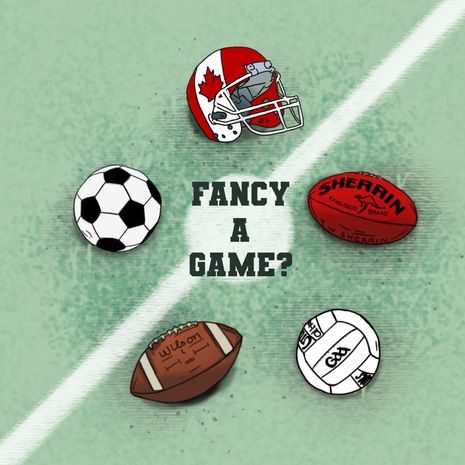What is Football?
Taking a global perspective, Jack Wadding considers the ambiguity of the word ‘football’ and discusses what it really means.

This might initially seem like a strange question to the majority of our readers, however, by taking a more global perspective, it starts to become a broad, complex and fascinating discussion. Being based in Britain, many Varsity readers would point me in the direction of the Premier League in my search for ‘football’.
However, readers from other parts of the world would each have a very different answer. If I were to talk generally about ‘footy’ in Australia, I would most likely be asked to clarify: Aussie Rules, Soccer, Rugby League or Union? As we will see, this is perhaps the most accurate application of the word, given its history. American or Canadian readers would show me the NFL or the CFL and Irish readers might give me the most complicated answer of all. Depending on where they came from, the community they grew up in and the context in which the conversation is being held, they might either talk to me about Gaelic, or Association.
So, why do anglophones across the world refer to seven different sports as ‘football’?
The simple answer is because, once upon a time, they were the same sport. With its origins in the mythical history of folk football, the sport was first organised in the elite public schools of Britain in the mid-19th century. The crucial point is, however, that each of these schools played by significantly different rules, allowing for different levels of handling, kicking and physicality. Every element of these rules is present, to varying extents, in at least one modern-day code of ‘football’. However, it would take over half a century for these codes to navigate the complex social dynamics of the anglophone world and develop into their own, recognisably different, sports.
In England, while the FA was founded in 1863 with the sole purpose of uniting all forms of ‘football’ under a uniform set of rules, by 1895, there were, in fact, three significantly different codes, each headed by a different organisation. The unsolvable problem was that the codes taken from each public school were just too different to be incorporated under the same roof. So, after four years of failure and with disbandment staring them in the face, the FA was forced to pick, hands or feet? As you probably now know, they went with feet; by 1870, they banned the use of the hand altogether, alienating proud Rugbeians. However, this experimental phase before 1870 is interestingly reflected by teams, like Blackheath, who had been founder members of the FA but subsequently resigned to form the RFU eight years later.
“This proved to be the rocket fuel that propelled soccer to assume the name ‘football’”
The next two decades were crucial in answering our question. The most likely reason we British refer to ‘soccer’ as ‘football’ is because, in this time and against the odds, it became the more popular code. Having acquired a substantial basis of teams following their promotion of the use of feet, the FA founded the Challenge Cup in 1871 – which was an instant hit. Despite starting off with only 15 entrants, by the end of the decade, there were 54, requiring seven rounds of games. Its popularity was mostly a result of the competition’s structure, whereby teams from different regions and classes could compete against one another on an unprecedentedly level playing field.
Due to the increased competitiveness and popularity of the FA Cup, players were increasingly paid (illegally and to the disgust of the gentlemen who ‘invented’ the game) to move to and play for another team. Following a drawn-out anti-professionalism struggle, the FA gave in and permitted regulated wages in 1885. This proved to be the rocket fuel that propelled soccer to assume the name ‘football’.
Having seen the ‘demise’ of football, the RFU took up a hardened stance against professionalism. So hard in fact, that it ruptured the sport in two, resulting in the founding of the NRFU in 1895. The RFU argued that it would rather maintain an amateur status than attract larger crowds, which meant that, by the mid-1890s, soccer had already been given a 10-year head start to gain popularity. At this point, the NRFU wanted to alter their rules in order to develop a more attractive game to try to make up the ground it had lost to soccer, primarily the removal of excessive scrums. This was the birth of rugby league.
In Australia, the story of ‘football’ was not too different. In much the same way that Old Rugbeians and Etonians brought their games to Cambridge, Australians who were sent to British boarding schools took the love of the game back home and, in 1859, founded a ‘Football Club’ in Melbourne. Between 1860 and 1890, the rules evolved to become different from rugby, on which it was originally loosely based, abandoning the offside rule, banning ball-carrying and increasing the importance of the mark, which had been present in many early forms of the game and is now an iconic feature of Aussie Rules. By 1896, both an amateur and a professional league had been established. Far less divided by class, the two leagues co-existed without the same antagonism that was witnessed in England. Eventually, the professional VFL eclipsed the amateur league in popularity, becoming the AFL in 1990. As a result, ‘football’ beat both soccer and rugby in capturing the hearts of the nation and became the dominant code.
“...the anglophone world had taken the ingredients provided by the public schools of Britain and formulated their own recipes...”
Very similarly, but more belatedly, the Americans and Canadians developed their own forms of ‘football’. Inspired by elite British schools, many of the now ‘Ivy League’ colleges picked up a form of the game as early as the 1820s. Having founded the Intercollegiate Football Association in 1876 (which took on a majority of the rules of the English RFU), the Americans, too, were getting bored by the constant scrums. So, in 1880, the number of men was reduced to eleven and the ‘snap-back’ was introduced to regulate the restart of play. The next year, the system of three downs to gain 5 yards was added. Over the next thirty years, trial and error, as with many codes of football, led to the development of solutions to given problems, which created the game as it looks today.
Finally, and perhaps most fascinatingly, Gaelic football was a product of the growing anti-British sentiment in Ireland in the late 19th century, which explains the complexity of meaning of the term ‘football’ there. Before the 1880s, rugby was the dominant code in Ireland and they competed in their first international in 1875. However, by the last decades of the 19th century, the Gaelic Revival was well underway and with it came a rejection of ‘British’ sport. Therefore, ‘football’ needed to be adapted to be significantly different from the codes of Britain. So, in 1884, the Gaelic Athletics Association was founded and by 1888 had developed a set of rules that did exactly that. Strikingly similar to the Australian game, the GAA had restricted ball-carrying and introduced posts on either side of the goals. By the turn of the century, these posts had been shifted above the goal and a points system had developed to dictate the weighting between scoring above or below the bar.
So, by the early years of the 20th century, the anglophone world had taken the ingredients provided by the public schools of Britain and formulated their own recipes, increasing the measurements of some elements and eliminating others altogether. Three different codes had been developed in England, two on the American continent, one in Ireland and another in Australia. By this time, all they shared was a common name: football. So, next time you find yourself agitated by a fellow anglophone using the word ‘soccer’, maybe take a second to remember that it was the English that invented the term in the first place.
 News / Uni Scout and Guide Club affirms trans inclusion 12 December 2025
News / Uni Scout and Guide Club affirms trans inclusion 12 December 2025 News / Cambridge Vet School gets lifeline year to stay accredited28 November 2025
News / Cambridge Vet School gets lifeline year to stay accredited28 November 2025 News / Pembroke to convert listed office building into accom9 December 2025
News / Pembroke to convert listed office building into accom9 December 2025 Science / Did your ex trip on King’s Parade? The science behind the ‘ick’12 December 2025
Science / Did your ex trip on King’s Parade? The science behind the ‘ick’12 December 2025 Features / Searching for community in queer Cambridge10 December 2025
Features / Searching for community in queer Cambridge10 December 2025









